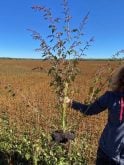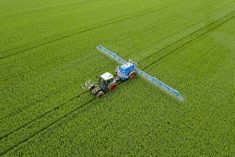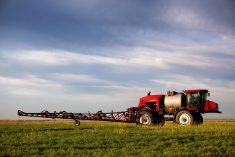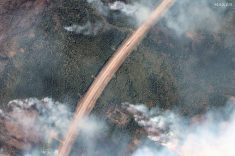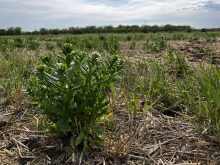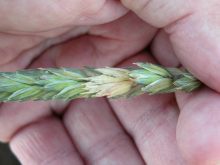Farmers are gearing up for spring seeding, but the weeds have already made it to the field.
Manitoba’s provincial weed specialist, Tammy Jones, says producers are already starting from behind on weed control this year, thanks in large part to harvest conditions last fall.
Why it matters: Seeding is stressful enough as is, but farmers this year are also expecting both increased weed pressure and a tight timeline to get down the fertilizer they missed out on last fall.
Some fields were still covered in snow March 31, the same day that Jones posted a picture of a growing kochia seedling, taken by a local agronomist in a field near Winkler, on social media.
The weed has garnered a lot of attention in recent years. Manitoba’s dry weather in 2018 and much of the growing season in 2019 helped proliferate the weed throughout the province, while municipalities reporting glyphosate-resistant kochia has steadily risen to a dozen by 2018 (seven more than in 2016). A survey done that same year found that 59 per cent of the 297 plants tested were resistant to herbicide in some way.

“Kochia, I think, maybe surprises some people, but it doesn’t take much warmth before it starts to germinate,” Jones said. “Fifty growing degree days need to accumulate. It doesn’t take much when you have a 10° day here or a 5° day there for kochia to germinate.”
Both kochia and lamb’s quarters share that short spring turnaround, Jones added.
Manitoba’s looming weed problem is yet another legacy of Manitoba’s “harvest from hell.” Wet conditions in late 2019 forced farmers to leave hundreds of thousands of acres unharvested, as well as leaving much of the province’s normal fertilizer, tillage and weed control passes undone.
Jones expects that to be a problem this spring. On top of last fall’s limited control, those same wet conditions left favourable moisture for early weeds, she said, as well as a prime opportunity for volunteer crop. Farmers likely lost more grain than normal last year given the tough crop and rush to get harvest in, and those seeds may come back to haunt them this spring, she noted.
Read Also

Manitoba sclerotinia picture mixed for 2025
Variations in weather and crop development in this year’s Manitoba canola fields make blanket sclerotinia outlooks hard to pin down
“I would anticipate that we will see a number of weeds that are having a great time,” she said.
Farmers should expect a harder fight against winter annuals in particular, according to Jones. Weeds that winter as rosettes are already greening, she said, and may actually begin flowering within a few weeks.
“Any of the winter annuals like stinkweed and shepherd’s purse and flixweed, we can see that they are starting to green up and get ready to grow,” she said. “And then Canada thistle, dandelion, foxtail barley, some of those perennials like quackgrass as well — starting to see those green up as well, and they’ll get a head start on a lot of the crop.”
The spring so far has also been friendly to weeds, she said, save a late dump of snow.
Temperatures tipped consistently above freezing in the last week of March before falling in early April, along with the arrival of over 10 centimetres of snow over parts of Manitoba. Temperatures were expected to jump between the near double digits and near freezing for the first two weeks of April, according to Environment and Climate Change Canada.
Getting ahead
Farmers may take the chance to get a jump on early weed identification.
The province has typically held weed seedling identification days each year, although the season’s first weeds have typically passed the seedling stage by the time of the event. That will not be the case if producers take an early walk in the field.
Weeds are, however, sometimes difficult to identify before the two-leaf or four-leaf stage, Jones said.
“That’s usually an important time as well, because that’s when you’re looking at, ‘how many days do I have until I can make a herbicide application that’s going to be really effective controlling that stage of growth with that particular weed.’”
The same rosette weeds that Jones identified as an early threat this year are also at high risk of mistaken identity, attendees were told at one such seedling identification day in 2018.
The province’s weed seedling identification guide is currently out of print, according to the Manitoba Agriculture and Resource Development website, although a new version was expected in 2020.
Finding hours
Farmers expect weed issues to complicate what was already going to be a more complicated spring. Fall conditions have also set fertilizer plans in disarray, as little fall fertilizer was applied. Suppliers also face the new reality of the COVID-19 pandemic, which has led to questions over timely input shipments.
Spring weed control adds yet one more thing for producers to take care of before actually getting seed in the ground, Jones acknowledged.
“It’s going to be a choice, but it can’t mean that we just ignore the weeds and wait for that to be an in-crop application, because for a lot of those weeds that start so early, by the time we get to in-crop herbicide application or other methods for controlling them, they’ll be at a (larger) stage and it’ll be really challenging to do anything effective for weed control,” she said. “While it might be a time crunch, it’s still important to think about how you’re going to effectively manage those weeds, making sure that you’re doing whatever pre-seed tillage or whatever herbicide applications ahead of time to help get that crop off to the best start that it can have.
“I recognize that fertilizer is important,” she added, “but there is also a critical weed-free period that helps establish the yield potential of the crop and you sort of need to be able to make the concessions for maybe a day or two delay in seeding in order to make sure the weed control is done effectively.”
Exact plans will differ from field to field, depending on weather and field conditions, she noted.








